Visualizing Hot Topics Using Python To Analyze News Sitemaps via @sejournal, @KorayGubur
Become more competitive in the news landscape with this educational Python coding session, including the most popular languages, words, genres, and ngrams for News SEO. The post Visualizing Hot Topics Using Python To Analyze News Sitemaps appeared first on...

News sitemaps use different and unique sitemap protocols to provide more information for the news search engines.
A news sitemap contains the news published in the last 48 hours.
News sitemap tags include the news publication’s title, language, name, genre, publication date, keywords, and even stock tickers.
How can you use these sitemaps to your advantage for content research and competitive analysis?
In this Python tutorial, you’ll learn a 10-step process for analyzing news sitemaps and visualizing topical trends discovered therein.
Jump to:
Housekeeping Notes To Get Us StartedWhat You Need To Analyze News Content With Python10 Steps For News Sitemap Analysis With PythonFinal Thoughts On News Sitemap Analysis With PythonHousekeeping Notes To Get Us Started
This tutorial was written during Russia’s invasion of Ukraine.
Using machine learning, we can even label news sources and articles according to which news source is “objective” and which news source is “sarcastic.”
But to keep things simple, we will focus on topics with frequency analysis.
We will use more than 10 global news sources across the U.S. and U.K.
Note: We would like to include Russian news sources, but they do not have a proper news sitemap. Even if they had, they block the external requests.
Comparing the word occurrence of “invasion” and “liberation” from Western and Eastern news sources shows the benefit of distributional frequency text analysis methods.
What You Need To Analyze News Content With Python
The related Python libraries for auditing a news sitemap to understand the news source’s content strategy are listed below:
Advertools. Pandas. Plotly Express, Subplots, and Graph Objects. Re (Regex). String. NLTK (Corpus, Stopwords, Ngrams). Unicodedata. Matplotlib. Basic Python Syntax Understanding.10 Steps For News Sitemap Analysis With Python
All set up? Let’s get to it.
1. Take The News URLs From News Sitemap
We chose the “The Guardian,” “New York Times,” “Washington Post,” “Daily Mail,” “Sky News,” “BBC,” and “CNN” to examine the News URLs from the News Sitemaps.
df_guardian = adv.sitemap_to_df("http://www.theguardian.com/sitemaps/news.xml") df_nyt = adv.sitemap_to_df("https://www.nytimes.com/sitemaps/new/news.xml.gz") df_wp = adv.sitemap_to_df("https://www.washingtonpost.com/arcio/news-sitemap/") df_bbc = adv.sitemap_to_df("https://www.bbc.com/sitemaps/https-index-com-news.xml") df_dailymail = adv.sitemap_to_df("https://www.dailymail.co.uk/google-news-sitemap.xml") df_skynews = adv.sitemap_to_df("https://news.sky.com/sitemap-index.xml") df_cnn = adv.sitemap_to_df("https://edition.cnn.com/sitemaps/cnn/news.xml")2. Examine An Example News Sitemap With Python
I have used BBC as an example to demonstrate what we just extracted from these news sitemaps.
df_bbc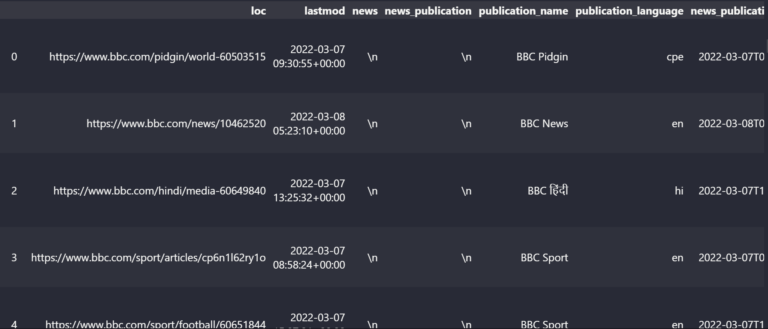 News Sitemap Data Frame View
News Sitemap Data Frame View
The BBC Sitemap has the columns below.
df_bbc.columns News Sitemap Tags as data frame columns
News Sitemap Tags as data frame columns
The general data structures of these columns are below.
df_bbc.info()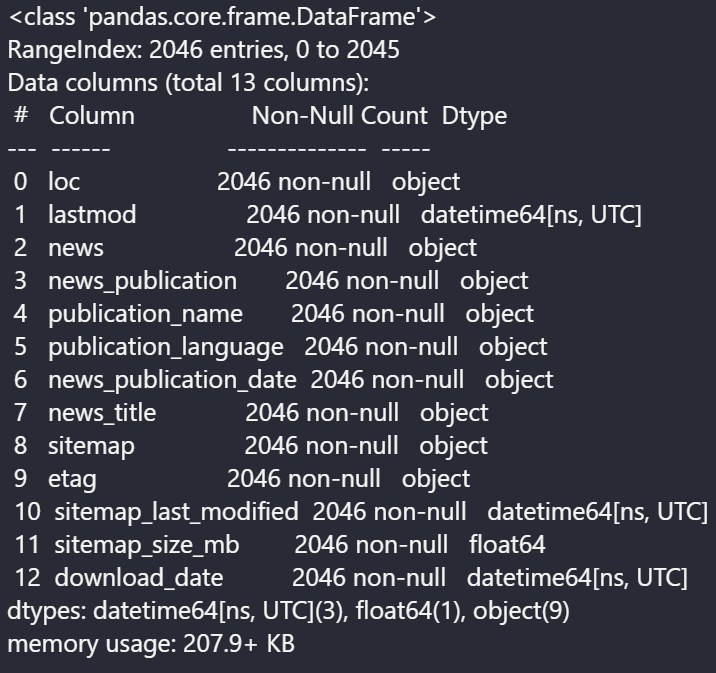 News Sitemap Columns and Data types
News Sitemap Columns and Data types
The BBC doesn’t use the “news_publication” column and others.
3. Find The Most Used Words In URLs From News Publications
To see the most used words in the news sites’ URLs, we need to use “str,” “explode”, and “split” methods.
df_dailymail["loc"].str.split("/").str[5].str.split("-").explode().value_counts().to_frame()| 176 |
| 50 |
| 50 |
| 38 |
| 38 |
| ... |
| 1 |
| 1 |
| 1 |
| 1 |
| 1 |
We see that for the “Daily Mail,” “Russia and Ukraine” are the main topic.
4. Find The Most Used Language In News Publications
The URL structure or the “language” section of the news publication can be used to see the most used languages in news publications.
In this sample, we used “BBC” to see their language prioritization.
df_bbc["publication_language"].head(20).value_counts().to_frame()| publication_language | |
| en | 698 |
| fa | 52 |
| sr | 52 |
| ar | 47 |
| mr | 43 |
| hi | 43 |
| gu | 41 |
| ur | 35 |
| pt | 33 |
| te | 31 |
| ta | 31 |
| cy | 30 |
| ha | 29 |
| tr | 28 |
| es | 25 |
| sw | 22 |
| cpe | 22 |
| ne | 21 |
| pa | 21 |
| yo | 20 |
To reach out to the Russian population via Google News, every western news source should use the Russian language.
Some international news institutions started to perform this perspective.
If you are a news SEO, it’s helpful to watch Russian language publications from competitors to distribute the objective news to Russia and compete within the news industry.
5. Audit The News Titles For Frequency Of Words
We used BBC to see the “news titles” and which words are more frequent.
df_bbc["news_title"].str.split(" ").explode().value_counts().to_frame()| 232 |
| 181 |
| 141 |
| 140 |
| 138 |
| ... |
| 1 |
| 1 |
| 1 |
| 1 |
| 1 |
The problem here is that we have “every type of word in the news titles,” such as “contextless stop words.”
We need to clean these types of non-categorical terms to understand their focus better.
from nltk.corpus import stopwords stop = stopwords.words('english') df_bbc_news_title_most_used_words = df_bbc["news_title"].str.split(" ").explode().value_counts().to_frame() pat = r'\b(?:{})\b'.format('|'.join(stop)) df_bbc_news_title_most_used_words.reset_index(drop=True, inplace=True) df_bbc_news_title_most_used_words["without_stop_words"] = df_bbc_news_title_most_used_words["words"].str.replace(pat,"") df_bbc_news_title_most_used_words.drop(df_bbc_news_title_most_used_words.loc[df_bbc_news_title_most_used_words["without_stop_words"]==""].index, inplace=True) df_bbc_news_title_most_used_words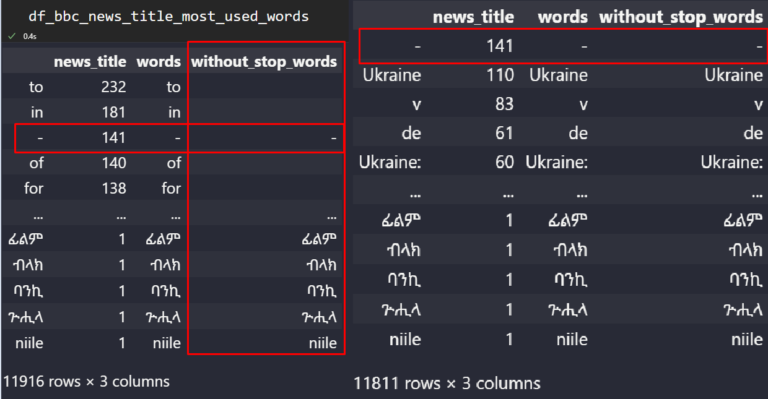 The “without_stop_words” column involves the cleaned text values.
The “without_stop_words” column involves the cleaned text values.
We have removed most of the stop words with the help of the “regex” and “replace” method of Pandas.
The second concern is removing the “punctuations.”
For that, we will use the “string” module of Python.
import string df_bbc_news_title_most_used_words["without_stop_word_and_punctation"] = df_bbc_news_title_most_used_words['without_stop_words'].str.replace('[{}]'.format(string.punctuation), '') df_bbc_news_title_most_used_words.drop(df_bbc_news_title_most_used_words.loc[df_bbc_news_title_most_used_words["without_stop_word_and_punctation"]==""].index, inplace=True) df_bbc_news_title_most_used_words.drop(["without_stop_words", "words"], axis=1, inplace=True) df_bbc_news_title_most_used_words| 110 | Ukraine |
| 83 | v |
| 61 | de |
| 60 | Ukraine |
| 51 | da |
| ... | ... |
| 1 | ፊልም |
| 1 | ብላክ |
| 1 | ባንኪ |
| 1 | ጕሒላ |
| 1 | niile |
Or, use “df_bbc_news_title_most_used_words[“news_title”].to_frame()” to take a more clear picture of data.
| 110 |
| 83 |
| 61 |
| 60 |
| 51 |
| ... |
| 1 |
| 1 |
| 1 |
| 1 |
| 1 |
We see 11,767 unique words in the URLs of the BBC, and Ukraine is the most popular, with 110 occurrences.
There are different Ukraine-related phrases from the data frame, such as “Ukraine:.”
The “NLTK Tokenize” can be used to unite these types of different variations.
The next section will use a different method to unite them.
Note: If you want to make things easier, use Advertools as below.
adv.word_frequency(df_bbc["news_title"],phrase_len=2, rm_words=adv.stopwords.keys())The result is below.
 Text Analysis with Advertools
Text Analysis with Advertools
“adv.word_frequency” has the attributes “phrase_len” and “rm_words” to determine the length of the phrase occurrence and remove the stop words.
You may tell me, why didn’t I use it in the first place?
I wanted to show you an educational example with “regex, NLTK, and the string” so that you can understand what’s happening behind the scenes.
6. Visualize The Most Used Words In News Titles
To visualize the most used words in the news titles, you can use the code block below.
df_bbc_news_title_most_used_words["news_title"] = df_bbc_news_title_most_used_words["news_title"].astype(int) df_bbc_news_title_most_used_words["without_stop_word_and_punctation"] = df_bbc_news_title_most_used_words["without_stop_word_and_punctation"].astype(str) df_bbc_news_title_most_used_words.index = df_bbc_news_title_most_used_words["without_stop_word_and_punctation"] df_bbc_news_title_most_used_words["news_title"].head(20).plot(title="The Most Used Words in BBC News Titles") News NGrams Visualization
News NGrams Visualization
You realize that there is a “broken line.”
Do you remember the “Ukraine” and “Ukraine:” in the data frame?
When we remove the “punctuation,” the second and first values become the same.
That’s why the line graph says that Ukraine appeared 60 times and 110 times separately.
To prevent such a data discrepancy, use the code block below.
df_bbc_news_title_most_used_words_1 = df_bbc_news_title_most_used_words.drop_duplicates().groupby('without_stop_word_and_punctation', sort=False, as_index=True).sum() df_bbc_news_title_most_used_words_1| 175 |
| 83 |
| 61 |
| 51 |
| 41 |
| ... |
| 1 |
| 1 |
| 1 |
| 1 |
| 1 |
The duplicated rows are dropped, and their values are summed together.
Now, let’s visualize it again.
7. Extract Most Popular N-Grams From News Titles
Extracting n-grams from the news titles or normalizing the URL words and forming n-grams for understanding the overall topicality is useful to understand which news publication approaches which topic. Here’s how.
import nltk import unicodedata import re def text_clean(content): lemmetizer = nltk.stem.WordNetLemmatizer() stopwords = nltk.corpus.stopwords.words('english') content = (unicodedata.normalize('NFKD', content) .encode('ascii', 'ignore') .decode('utf-8', 'ignore') .lower()) words = re.sub(r'[^\w\s]', '', content).split() return [lemmetizer.lemmatize(word) for word in words if word not in stopwords] raw_words = text_clean(''.join(str(df_bbc['news_title'].tolist()))) raw_words[:10] OUTPUT>>> ['oneminute', 'world', 'news', 'best', 'generation', 'make', 'agyarkos', 'dream', 'fight', 'card']The output shows we have “lemmatized” all the words in the news titles and put them in a list.
The list comprehension provides a quick shortcut for filtering every stop word easily.
Using “nltk.corpus.stopwords.words(“english”)” provides all the stop words in English.
But you can add extra stop words to the list to expand the exclusion of words.
The “unicodedata” is to canonicalize the characters.
The characters that we see are actually Unicode bytes like “U+2160 ROMAN NUMERAL ONE” and the Roman Character “U+0049 LATIN CAPITAL LETTER I” are actually the same.
The “unicodedata.normalize” distinguishes the character differences so that the lemmatizer can differentiate the different words with similar characters from each other.
pd.set_option("display.max_colwidth",90) bbc_bigrams = (pd.Series(ngrams(words, n = 2)).value_counts())[:15].sort_values(ascending=False).to_frame() bbc_trigrams = (pd.Series(ngrams(words, n = 3)).value_counts())[:15].sort_values(ascending=False).to_frame()Below, you will see the most popular “n-grams” from BBC News.
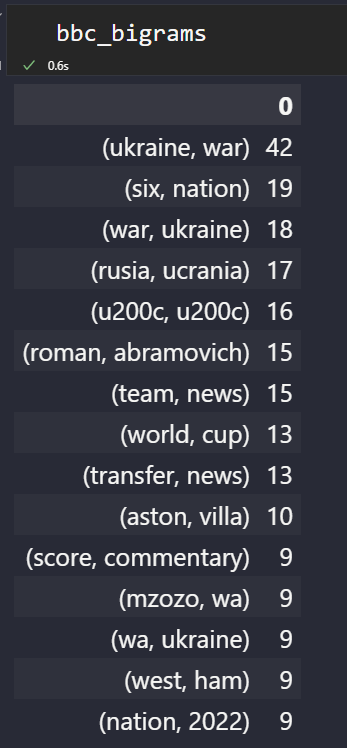 NGrams Dataframe from BBC
NGrams Dataframe from BBC
To simply visualize the most popular n-grams of a news source, use the code block below.
bbc_bigrams.plot.barh(color="red", width=.8,figsize=(10 , 7))“Ukraine, war” is the trending news.
You can also filter the n-grams for “Ukraine” and create an “entity-attribute” pair.
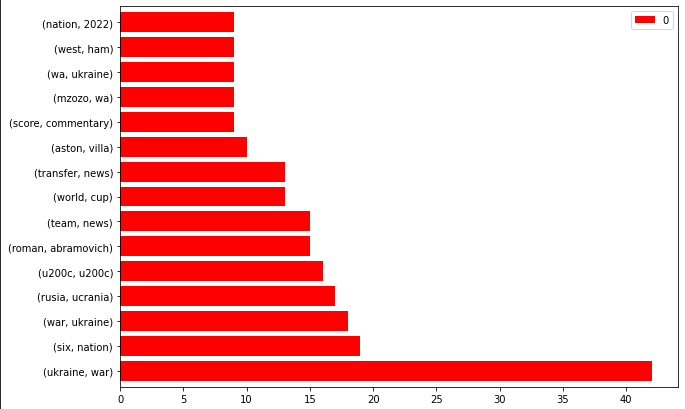 News Sitemap NGrams from BBC
News Sitemap NGrams from BBC
Crawling these URLs and recognizing the “person type entities” can give you an idea about how BBC approaches newsworthy situations.
But it is beyond “news sitemaps.” Thus, it is for another day.
To visualize the popular n-grams from news source’s sitemaps, you can create a custom python function as below.
def ngram_visualize(dataframe:pd.DataFrame, color:str="blue") -> pd.DataFrame.plot: dataframe.plot.barh(color=color, width=.8,figsize=(10 ,7)) ngram_visualize(ngram_extractor(df_dailymail))The result is below.
 News Sitemap Trigram Visualization
News Sitemap Trigram Visualization
To make it interactive, add an extra parameter as below.
def ngram_visualize(dataframe:pd.DataFrame, backend:str, color:str="blue", ) -> pd.DataFrame.plot: if backend=="plotly": pd.options.plotting.backend=backend return dataframe.plot.bar() else: return dataframe.plot.barh(color=color, width=.8,figsize=(10 ,7)) ngram_visualize(ngram_extractor(df_dailymail), backend="plotly")As a quick example, check below.
8. Create Your Own Custom Functions To Analyze The News Source Sitemaps
When you audit news sitemaps repeatedly, there will be a need for a small Python package.
Below, you can find four different quick Python function chain that uses every previous function as a callback.
To clean a textual content item, use the function below.
def text_clean(content): lemmetizer = nltk.stem.WordNetLemmatizer() stopwords = nltk.corpus.stopwords.words('english') content = (unicodedata.normalize('NFKD', content) .encode('ascii', 'ignore') .decode('utf-8', 'ignore') .lower()) words = re.sub(r'[^\w\s]', '', content).split() return [lemmetizer.lemmatize(word) for word in words if word not in stopwords]To extract the n-grams from a specific news website’s sitemap’s news titles, use the function below.
def ngram_extractor(dataframe:pd.DataFrame|pd.Series): if "news_title" in dataframe.columns: return dataframe_ngram_extractor(dataframe, ngram=3, first=10)Use the function below to turn the extracted n-grams into a data frame.
def dataframe_ngram_extractor(dataframe:pd.DataFrame|pd.Series, ngram:int, first:int): raw_words = text_clean(''.join(str(dataframe['news_title'].tolist()))) return (pd.Series(ngrams(raw_words, n = ngram)).value_counts())[:first].sort_values(ascending=False).to_frame()To extract multiple news websites’ sitemaps, use the function below.
def ngram_df_constructor(df_1:pd.DataFrame, df_2:pd.DataFrame): df_1_bigrams = dataframe_ngram_extractor(df_1, ngram=2, first=500) df_1_trigrams = dataframe_ngram_extractor(df_1, ngram=3, first=500) df_2_bigrams = dataframe_ngram_extractor(df_2, ngram=2, first=500) df_2_trigrams = dataframe_ngram_extractor(df_2, ngram=3, first=500) ngrams_df = { "df_1_bigrams":df_1_bigrams.index, "df_1_trigrams": df_1_trigrams.index, "df_2_bigrams":df_2_bigrams.index, "df_2_trigrams": df_2_trigrams.index, } dict_df = (pd.DataFrame({ key:pd.Series(value) for key, value in ngrams_df.items() }).reset_index(drop=True) .rename(columns={"df_1_bigrams":adv.url_to_df(df_1["loc"])["netloc"][1].split("www.")[1].split(".")[0] + "_bigrams", "df_1_trigrams":adv.url_to_df(df_1["loc"])["netloc"][1].split("www.")[1].split(".")[0] + "_trigrams", "df_2_bigrams": adv.url_to_df(df_2["loc"])["netloc"][1].split("www.")[1].split(".")[0] + "_bigrams", "df_2_trigrams": adv.url_to_df(df_2["loc"])["netloc"][1].split("www.")[1].split(".")[0] + "_trigrams"})) return dict_dfBelow, you can see an example use case.
ngram_df_constructor(df_bbc, df_guardian)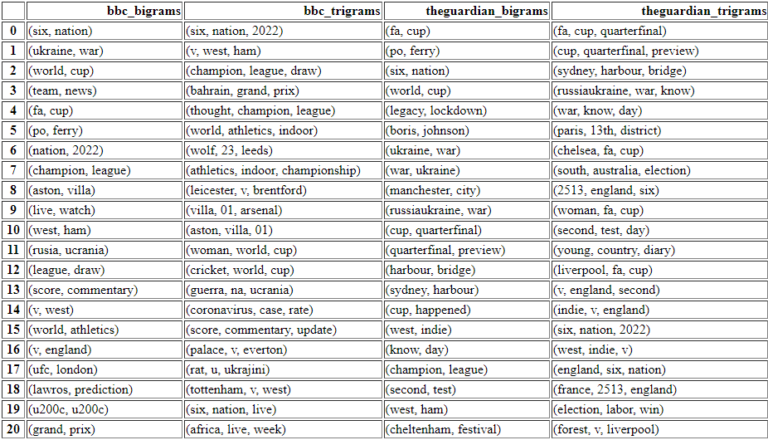 Popular Ngram Comparison to see the news websites’ focus.
Popular Ngram Comparison to see the news websites’ focus.
Only with these nested four custom python functions can you do the things below.
Easily, you can visualize these n-grams and the news website counts to check. You can see the focus of the news websites for the same topic or different topics. You can compare their wording or the vocabulary for the same topics. You can see how many different sub-topics from the same topics or entities are processed in a comparative way.I didn’t put the numbers for the frequencies of the n-grams.
But, the first ranked ones are the most popular ones from that specific news source.
To examine the next 500 rows, click here.
9. Extract The Most Used News Keywords From News Sitemaps
When it comes to news keywords, they are surprisingly still active on Google.
For example, Microsoft Bing and Google do not think that “meta keywords” are a useful signal anymore, unlike Yandex.
But, news keywords from the news sitemaps are still used.
Among all these news sources, only The Guardian uses the news keywords.
And understanding how they use news keywords to provide relevance is useful.
df_guardian["news_keywords"].str.split().explode().value_counts().to_frame().rename(columns={"news_keywords":"news_keyword_occurence"})You can see the most used words in the news keywords for The Guardian.
| 250 |
| 142 |
| 142 |
| 127 |
| 116 |
| ... |
| 1 |
| 1 |
| 1 |
| 1 |
| 1 |
The visualization is below.
(df_guardian["news_keywords"].str.split().explode().value_counts() .to_frame().rename(columns={"news_keywords":"news_keyword_occurence"}) .head(25).plot.barh(figsize=(10,8), title="The Guardian Most Used Words in News Keywords", xlabel="News Keywords", legend=False, ylabel="Count of News Keyword")) Most Popular Words in News Keywords
Most Popular Words in News Keywords
The “,” at the end of the news keywords represent whether it is a separate value or part of another.
I suggest you not remove the “punctuations” or “stop words” from news keywords so that you can see their news keyword usage style better.
For a different analysis, you can use “,” as a separator.
df_guardian["news_keywords"].str.split(",").explode().value_counts().to_frame().rename(columns={"news_keywords":"news_keyword_occurence"})The result difference is below.
| 134 |
| 116 |
| 111 |
| 109 |
| 90 |
| ... |
| 1 |
| 1 |
| 1 |
| 1 |
| 1 |
Focus on the “split(“,”).”
(df_guardian["news_keywords"].str.split(",").explode().value_counts() .to_frame().rename(columns={"news_keywords":"news_keyword_occurence"}) .head(25).plot.barh(figsize=(10,8), title="The Guardian Most Used Words in News Keywords", xlabel="News Keywords", legend=False, ylabel="Count of News Keyword"))You can see the result difference for visualization below.
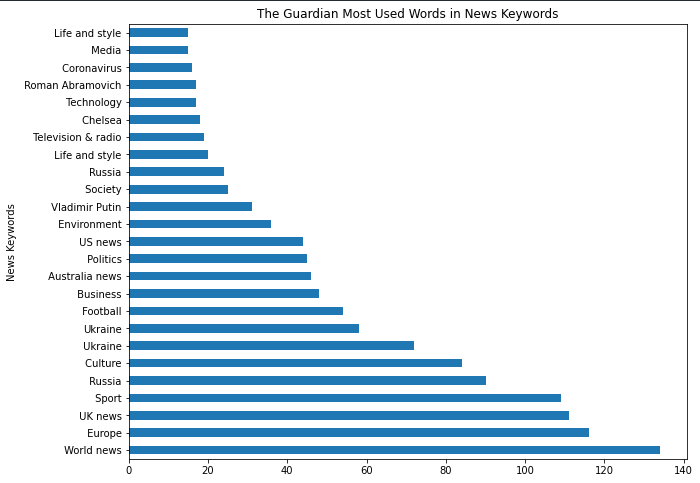 Most Popular Keywords from News Sitemaps
Most Popular Keywords from News Sitemaps
From “Chelsea” to “Vladamir Putin” or “Ukraine War” and “Roman Abramovich,” most of these phrases align with the early days of Russia’s Invasion of Ukraine.
Use the code block below to visualize two different news website sitemaps’ news keywords interactively.
df_1 = df_guardian["news_keywords"].str.split(",").explode().value_counts().to_frame().rename(columns={"news_keywords":"news_keyword_occurence"}) df_2 = df_nyt["news_keywords"].str.split(",").explode().value_counts().to_frame().rename(columns={"news_keywords":"news_keyword_occurence"}) fig = make_subplots(rows = 1, cols = 2) fig.add_trace( go.Bar(y = df_1["news_keyword_occurence"][:6].index, x = df_1["news_keyword_occurence"], orientation="h", name="The Guardian News Keywords"), row=1, col=2 ) fig.add_trace( go.Bar(y = df_2["news_keyword_occurence"][:6].index, x = df_2["news_keyword_occurence"], orientation="h", name="New York Times News Keywords"), row=1, col=1 ) fig.update_layout(height = 800, width = 1200, title_text="Side by Side Popular News Keywords") fig.show() fig.write_html("news_keywords.html")You can see the result below.
To interact with the live chart, click here.
In the next section, you will find two different subplot samples to compare the n-grams of the news websites.
10. Create Subplots For Comparing News Sources
Use the code block below to put the news sources’ most popular n-grams from the news titles to a sub-plot.
import matplotlib.pyplot as plt import pandas as pd df1 = ngram_extractor(df_bbc) df2 = ngram_extractor(df_skynews) df3 = ngram_extractor(df_dailymail) df4 = ngram_extractor(df_guardian) df5 = ngram_extractor(df_nyt) df6 = ngram_extractor(df_cnn) nrow=3 ncol=2 df_list = [df1 ,df2, df3, df4, df5, df6] #df6 titles = ["BBC News Trigrams", "Skynews Trigrams", "Dailymail Trigrams", "The Guardian Trigrams", "New York Times Trigrams", "CNN News Ngrams"] fig, axes = plt.subplots(nrow, ncol, figsize=(25,32)) count=0 i = 0 for r in range(nrow): for c in range(ncol): (df_list[count].plot.barh(ax = axes[r,c], figsize = (40, 28), title = titles[i], fontsize = 10, legend = False, xlabel = "Trigrams", ylabel = "Count")) count+=1 i += 1You can see the result below.
 Most Popular NGrams from News Sources
Most Popular NGrams from News Sources
The example data visualization above is entirely static and doesn’t provide any interactivity.
Lately, Elias Dabbas, creator of Advertools, has shared a new script to take the article count, n-grams, and their counts from the news sources.
Check here for a better, more detailed, and interactive data dashboard.
The example above is from Elias Dabbas, and he demonstrates how to take the total article count, most frequent words, and n-grams from news websites in an interactive way.
Final Thoughts On News Sitemap Analysis With Python
This tutorial was designed to provide an educational Python coding session to take the keywords, n-grams, phrase patterns, languages, and other kinds of SEO-related information from news websites.
News SEO heavily relies on quick reflexes and always-on article creation.
Tracking your competitors’ angles and methods for covering a topic shows how the competitors have quick reflexes for the search trends.
Creating a Google Trends Dashboard and News Source Ngram Tracker for a comparative and complementary news SEO analysis would be better.
In this article, from time to time, I have put custom functions or advanced for loops, and sometimes, I have kept things simple.
Beginners to advanced Python practitioners can benefit from it to improve their tracking, reporting, and analyzing methodologies for news SEO and beyond.
More resources:
8 Python Libraries For SEO & How To Use Them How To Automate SEO Keyword Clustering By Search Intent With Python Advanced Technical SEO: A Complete GuideFeatured Image: BestForBest/Shutterstock

 Konoly
Konoly 
































